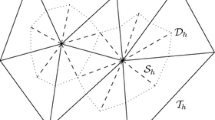Abstract
Lower a posteriori error bounds obtained using the standard bubble function approach are reviewed in the context of anisotropic meshes. A numerical example is given that clearly demonstrates that the short-edge jump residual terms in such bounds are not sharp. Hence, for linear finite element approximations of the Laplace equation in polygonal domains, a new approach is employed to obtain essentially sharper lower a posteriori error bounds and thus to show that the upper error estimator in the recent paper (Kopteva in Numer Math 137:607–642, 2017) is efficient on partially structured anisotropic meshes.


Similar content being viewed by others
References
Ainsworth, M., Oden, J.T.: A Posteriori Error Estimation in Finite Element Analysis. Wiley, New York (2000)
Kopteva, N.: Maximum-norm a posteriori error estimates for singularly perturbed reaction-diffusion problems on anisotropic meshes. SIAM J. Numer. Anal. 53, 2519–2544 (2015)
Kopteva, N.: Energy-norm a posteriori error estimates for singularly perturbed reaction-diffusion problems on anisotropic meshes. Numer. Math. 137, 607–642 (2017)
Kopteva, N.: Fully computable a posteriori error estimator using anisotropic flux equilibration on anisotropic meshes. arXiv:1704.04404 (2017)
Kopteva, N.: Lower a posteriori error estimates for singularly perturbed reaction-diffusion problems on anisotropic meshes (in preparation) (2020)
Kunert, G.: An a posteriori residual error estimator for the finite element method on anisotropic tetrahedral meshes. Numer. Math. 86, 471–490 (2000)
Kunert, G.: Robust a posteriori error estimation for a singularly perturbed reaction-diffusion equation on anisotropic tetrahedral meshes. Adv. Comput. Math. 15, 237–259 (2001)
Kunert, G., Verfürth, R.: Edge residuals dominate a posteriori error estimates for linear finite element methods on anisotropic triangular and tetrahedral meshes. Numer. Math. 86, 283–303 (2000)
Micheletti, S., Perotto, S.: Reliability and efficiency of an anisotropic Zienkiewicz-Zhu error estimator. Comput. Methods Appl. Mech. Eng. 195, 799–835 (2006)
Picasso, M.: Numerical study of the effectivity index for an anisotropic error indicator based on Zienkiewicz-Zhu error estimator. Commun. Numer. Methods Eng. 19, 13–23 (2003)
Verfürth, R.: A Posteriori Error Estimation Techniques for Finite Element Methods. Oxford University Press, Oxford (2013)
Xu, J., Zhang, Z.: Analysis of recovery type a posteriori error estimators for mildly structured grids. Math. Comput. 73, 1139–1152 (2004)
Author information
Authors and Affiliations
Corresponding author
Additional information
Publisher's Note
Springer Nature remains neutral with regard to jurisdictional claims in published maps and institutional affiliations.
The author was partially supported by Science Foundation Ireland Grant SFI/12/IA/1683.
Rights and permissions
About this article
Cite this article
Kopteva, N. Lower a posteriori error estimates on anisotropic meshes. Numer. Math. 146, 159–179 (2020). https://doi.org/10.1007/s00211-020-01137-9
Received:
Revised:
Published:
Issue Date:
DOI: https://doi.org/10.1007/s00211-020-01137-9




